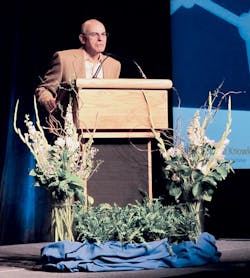Emerson Process Management held its annual Emerson Global Users Exchange Sept. 27-Oct. 1 in San Antonio. The event attracted in excess of 2,300 people, about a 20 percent increase over 2009.John Berra, the driving force behind the development of Emerson Process Management as a prominent automation supplier, not to mention the development of such technologies as Hart and Foundation Fieldbus, handed over the keys to the company to Steve Sonnenberg two years ago at the Emerson Exchange in Washington, D.C. Automation World Editor in Chief Gary Mintchell caught up with Berra during this year’s Exchange to get his thoughts about changes in the industry and technology over the span of his career.Asked about the importance of automation advances over the past 41 years to the operation of plants, Berra looked at different technologies and their use. “In those days, the system was all about control loops. There were huge rooms where sometimes operators even had to be on roller skates to get from one end to the other. When automation came along, it was kind of its own thing—an island with no connection to the business system. Whatever data was needed was recorded manually and keypunched into the system.”Digital advancesThe single most significant technology advance was digital technology moving into all devices, said Berra. “This enables more information to runs in parallel with the control system. This helps maintenance. And you can assess the life of rotating equipment. We are running more safely than back then, even though incident reporting in the press may make that look untrue. We are also running with fewer operators and other people—which may or may not be a good thing,” he added.Another benefit is connecting the automation to the company’s business systems. This aids decision-making, for example, in scheduling. Said Berra, “Batch plants need to schedule, but even refineries must handle more than one type of crude these days. So the ability to schedule these refineries for different crudes through automation brings flexibility. We really see this in life sciences, but also even in brewing beer, where they now make a lot of types of beer in a plant.”The automation industry in general influenced thinking on processes and designs—for example, using simulation not just for training but also for thought experiments. “You can’t test everything in the plant. In the long run, we’ll have simulation running alongside the process, but faster. This may be used for predictive control or maintenance,” he observed.“Automation engineers who do so much to automate the plants are often underappreciated. They need to know a little about many things now, such as mechanical, electrical, electronics, networking, safety and security.”Regarding the impact of all these changes on process instrumentation and automation suppliers, Berra said, “They now have to have the ability to manage projects. And they now have to have a global organization.”Under Berra’s watch, Emerson Process Management grew into a $6 billion global business. Much of the growth was fueled by acquisition. Given that not all companies have a successful track record for making acquisitions work, Berra shared some thoughts on the Emerson system.“Emerson, itself, has a good track record of identifying and bringing in acquisitions. So our process built on that. Create some number of critical action teams composed of people from both companies. They are organized on specific issues. Typically, they already are selling and have a sales force, so if you wait too long to fill out that organization and figure out details that affect people, they suspect the worst. The acquirer isn’t all-seeing, all-knowing, so you need to bring in the acquired company. With the Fisher acquisition, our largest, we had 17 teams. Each had defined scope and deadlines—usually defined in months. The team had to present a report to executives—Chuck Knight at that time, or later, Dave Farr.”People processAssembling teams from both companies starts the process of people getting to know each other. Added Berra, “The first meeting is all about feeling each other out. But knowing they’ve got to present to Emerson CEOs Chuck Knight or Dave Farr gets them started. The most important thing is to get started and to provide clarity on management structure. We didn’t buy ‘fixer-uppers,’ so people at the companies we bought must know something. You just don’t go in and replace management. Even look at things that impact every employee, such as medical plans, where the checks come from.”Not every acquisition was successful, Berra acknowledged, but certainly, plenty were.Some pundits have suggested that big companies cannot be innovative. Berra offers a different opinion based on his experience at Emerson. “I think you can foster a culture of innovation in a big company. But you need to foster smaller groups. It’s hard to do it in a big research-and-development organization. Although, sometimes you need a central R&D organization to develop things that can be leveraged across the entire company—for example, ASIC (application-specific integrated circuit) chips. But when it comes to the core competency of each division, those developers know what they need to work on. I just don’t agree that big companies can’t innovate,” Berra concluded.Emerson Process Managementwww.emersonprocess.com
Subscribe to Automation World's RSS Feeds for Feature Articles

